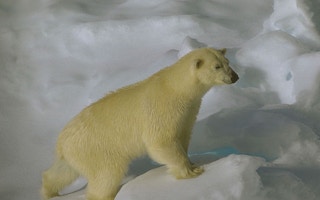Scientists have identified a new climate menace in the rapidly warming Arctic. As soils frozen for tens of thousands of years begin to thaw, they could surrender vast quantities of nitrous oxide to accelerate further global warming.
Nitrous oxide or N2O, known also as laughing gas, is one of the minor greenhouse gases, but molecule for molecule it is almost 300 times more potent than carbon dioxide. And permafrost with the potential to release nitrous oxide covers about a fourth of the Arctic.
Researchers led by Carolina Voigt from the University of Eastern Finland report in the Proceedings of the National Academy of Sciences that they experimented with what they call mesocosms of peaty soils from the Arctic: in a compromise between the microcosm of a laboratory experiment and open field trials on the tundra, the scientists collected 16 columns of peat, some topped with natural vegetation, from Finnish Lapland.
They set these mesocosms up in a climate-controlled chamber, replicated natural light, moisture and temperature conditions, and monitored them for 33 weeks. They replicated natural seasonal thaws of the upper soils, and the deep and long-term thaw of the permafrost.
“
Our results imply that the Arctic N2O budget will depend strongly on moisture changes, and that a gradual deepening of the active layer will create a strong non-carbon climate change feedback.
Scientists, University of Eastern Finland
Tropical parallel
And they found that the highest post-thaw emissions of nitrous oxide came from the bare peat soils: these emissions were fivefold those from still-frozen soils and matched the kind of outgassing observed in tropical soils, which are the world’s largest natural land-based nitrous oxide source.
If the peat columns were covered by vegetation, then emissions fell up to by 90 per cent. If the peat soils were waterlogged, nitrous oxide release was entirely suppressed.
This, once again, is basic or fundamental research: it leaves the big questions unresolved. But it also demonstrates another reason for international concern over the rapid and dramatic warming of the Arctic.
The permafrost is a vast reservoir of ancient carbon, protected from decay by microorganisms simply by its frozen state: it becomes increasingly vulnerable as the world warms, as humans burn fossil fuels and dump ever greater concentrations of carbon dioxide in the atmosphere.
Since the Arctic is warming faster than the rest of the planet, the release of carbon dioxide from the thawing soils, and also of vast quantities of methane, will almost certainly accelerate global warming yet further.
And since the predicted range of warming for the Arctic by the century’s end is 5.6°C at a conservative estimate and 12.4°C at the most, the permafrost may be seen as yet another dangerous factor in the global warming equation.
The Finnish researchers have just added to the anxiety, because, they point out, the upper three metres of the permafrost are home to – once again, at a very conservative estimate – 67 billion tonnes of nitrogen. This is 500 times the amount of nitrogen added to soils as fertiliser worldwide by farmers.
“Our results,” they report, “imply that the Arctic N2O budget will depend strongly on moisture changes, and that a gradual deepening of the active layer will create a strong non-carbon climate change feedback.”
This story was published with permission from Climate News Network.








